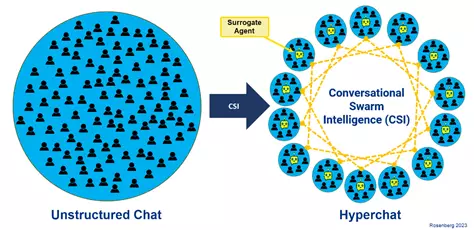Imagine a brainstorming session that transcends the limitations of traditional group discussions—a session where insights flow freely, ideas are evaluated almost in real-time, and solutions emerge organically from diverse minds working in tandem. This is not merely a dream; it is an evolution in collaborative technology known as hyperchat or conversational swarm intelligence. By leveraging this innovative platform, teams, regardless of their size, can engage in dynamic exchanges that propel them towards AI-optimized solutions. The question remains: can a large group truly enhance its collective thinking capacity through this technology? The answer is not only promising; it is groundbreaking.
Understanding the Limitations of Traditional Group Dynamics
In conventional settings, the effectiveness of group discussions diminishes as the number of participants increases. Research indicates that optimal group sizes for productive dialogue range from four to seven individuals. Beyond this threshold, discussions often devolve into chaos—conversations become monologues, members wait longer for their turn to speak, and critical insights risk being overshadowed amidst the noise of competing voices. This convoluted dynamic hampers the effectiveness of larger groups, making it nearly impossible for them to operate as a cohesive unit in brainstorming sessions or problem-solving endeavors.
Recognizing these limitations, hyperchat technology was invented as a solution that democratizes discussions while enhancing productivity. By fracturing large teams into smaller, efficiently managed sub-groups, this innovative platform allows for simultaneous dialogues. Each subgroup is augmented with an AI “conversational surrogate,” a dedicated agent tasked with capturing and synthesizing collective insights. The result is an integrated conversation that respects the individuality of input while harnessing the power of the collective.
The Mechanics Behind Hyperchat Technology
At the core of hyperchat technology is its ability to facilitate parallel conversations among subgroups, enabling a fluid exchange of ideas. These sub-teams engage in brainstorming while the conversational surrogates streamline the results to inform the larger group discussion. This structure is designed not only for efficiency but also to significantly elevate the intelligence compiled from the group’s input. With the emergence of commercial applications—such as Thinkscape®—hundreds of participants can now deliberate intelligently in real-time settings.
A key experiment illustrates the potential of hyperchat technology in action. Recently, 50 random sports fans collaborated via the Thinkscape platform to assemble the ultimate March Madness bracket. The performance of this group has been noteworthy, ranking in the 99th percentile of a contest against 30 million other entries. This success exemplifies the effectiveness of collective intelligence catalyzed by hyperchat, revealing the unforeseen capabilities of previously diverse individuals working together seamlessly.
Empirical Evidence of Enhanced Intelligence
Recent studies have further validated the effectiveness of hyperchat. In research conducted by Carnegie Mellon and Unanimous AI, groups were tested using traditional conversation methods versus hyperchat. The results were staggering; while individual participants in isolated settings achieved an average IQ of 100, the same groups boosted their effective IQ to 128 when engaging in hyperchat discussions. This leap to near “gifted” levels of cognitive performance underscores the efficacy of hyperchat in amplifying collective intelligence.
Moreover, participants reported a stronger sense of collaboration and agreement regarding solutions when using hyperchat rather than traditional mediums. The stats were compelling: individuals expressed feeling a higher degree of ownership over their discussions (pThe Future of Hybrid Intelligence and Decision Making
Hyperchat technology does not merely excel in gathering human insights; its true power lies in its hybrid approach. By merging human contribution with AI capabilities, the platform aims to create a collective superintelligence that continuously propels human teams toward optimal decisions. Incorporating another type of AI agent, known as a “contributor agent,” adds a layer of factual real-time support that complements ongoing discussions, ensuring informed decisions are made with the backing of reliable data.
As organizations grapple with decision-making bottlenecks that limit their operational efficacy, hyperchat emerges as a transformative solution. With the technology’s potential to scale across teams of thousands—such as those found within Fortune 1000 companies—organizations can finally harness the strengths of both human creativity and AI efficiency simultaneously. As observed in numerous studies, the blended interaction between human and AI agents fosters an environment where real-time conversations lead to enhanced decision quality.
The emergence of hyperchat marks a significant shift in how teams can collaborate, introducing a revolutionary model that embraces the power of collective intelligence. With ongoing advancements and applications, the future of collaborative work looks brighter than ever.

